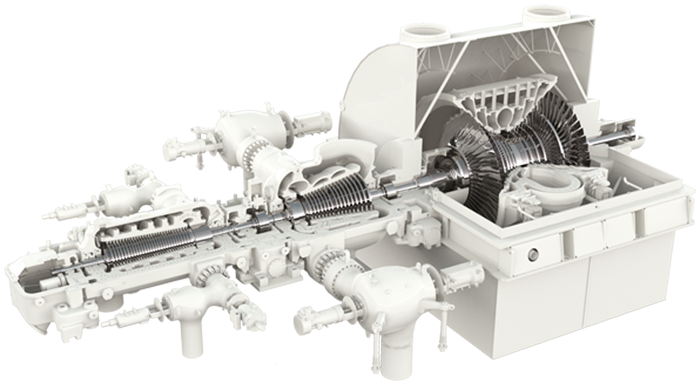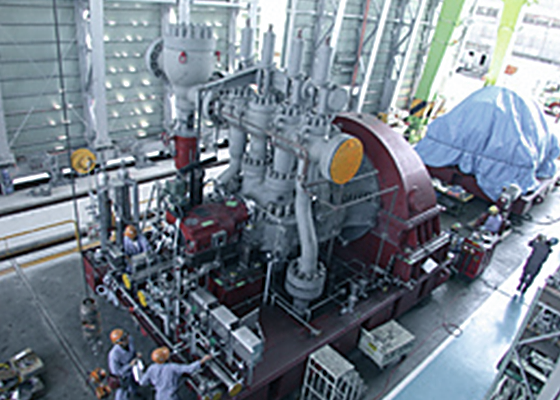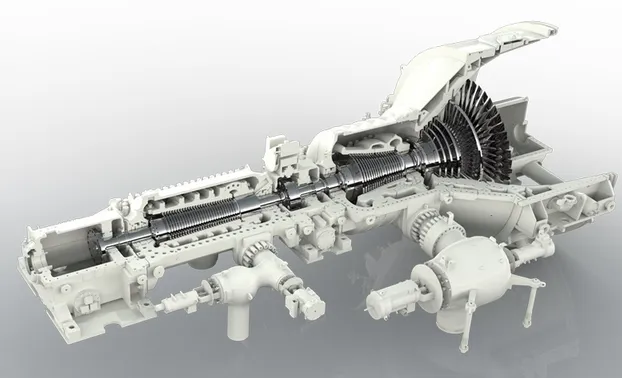OBSOLESCENCE vs WEAR OUT - SPECIAL STEAM TURBINES

DIFFERENCIES BETWEEN OBSOLESCENCE vs WEAR OUT ' SPECIAL STEAM TURBINES
When it comes to improving the reliability, availability, safety, and avoiding critical risks and failures in existing plants, it’s important to understand the differences between obsolescence and wear out in the context of special steam turbines used in power generation, oil, gas, and petrochemical industries. Let’s discuss each concept:
- Obsolescence: Obsolescence refers to the condition of being outdated or no longer in use. In the context of steam turbines, obsolescence can occur when certain components, technologies, or designs become outdated, unsupported, or difficult to procure. This can lead to challenges in maintaining and repairing the turbines. Obsolescence can be caused by various factors, such as advancements in technology, changes in industry standards, discontinuation of parts by manufacturers, or the aging of equipment.
To improve reliability, availability, and safety while avoiding critical risks and failures due to obsolescence, the following steps can be taken:
a. Obsolescence management: Implement a proactive approach to identify and address potential obsolescence issues in advance. This includes monitoring the lifecycle of components, tracking industry trends, and working closely with suppliers and manufacturers to find suitable replacement parts or upgrade options.
b. Retrofitting and modernization: Consider retrofitting or modernizing existing steam turbines to incorporate newer technologies and designs. This can involve replacing obsolete components, improving control systems, or upgrading safety features to enhance overall performance and extend the turbine’s lifespan.
c. Spare parts management: Maintain an inventory of critical spare parts to mitigate the risks associated with obsolescence. This involves identifying key components that are prone to obsolescence and ensuring an adequate supply of replacements to minimize downtime and support efficient maintenance practices.
- Wear out: Wear out refers to the gradual deterioration of equipment or components over time due to normal usage, stress, or fatigue. In the case of steam turbines, wear out can occur in various areas, such as bearings, seals, blades, and other high-stress components. It can result from factors like thermal cycling, mechanical stresses, erosion, corrosion, and fatigue.
To improve reliability, availability, safety, and prevent failures due to wear out, the following measures can be implemented:
a. Condition monitoring: Implement a robust condition monitoring program to regularly assess the health and performance of critical components. This includes techniques such as vibration analysis, thermography, oil analysis, and non-destructive testing. By identifying early signs of wear or deterioration, maintenance activities can be scheduled in a predictive or proactive manner, reducing the likelihood of unexpected failures.
b. Preventive maintenance: Develop and adhere to a comprehensive preventive maintenance plan that includes periodic inspections, lubrication, alignment checks, and cleaning. This helps to detect and address potential wear-related issues before they escalate into failures.
c. Component refurbishment or replacement: Establish guidelines for refurbishing or replacing components that have reached their wear limits or are showing signs of significant degradation. This can involve reconditioning worn parts, replacing damaged components, or upgrading to more durable materials.
It is crucial to implement a combination of obsolescence management and wear out prevention strategies to enhance the reliability, availability, safety, and overall performance of special steam turbines in existing plants. Regular monitoring, proactive maintenance practices, and a forward-thinking approach to equipment lifecycle management can help mitigate risks and avoid critical failures.

LIMITS IN ENGINEERING & DESIGN - OBSOLESCENCE vs WEAR OUT
Special steam turbines play a crucial role in power generation, oil, gas, and petrochemical industries. To improve their reliability, availability, maintainability, safety, and mitigate critical and environmental failures and risks, it is essential to consider the limits in engineering and design between obsolescence and wear out. Let’s delve into these limitations in detail.
One of the key limitations in engineering and design of special steam turbines is the presence of design constraints. These turbines are often custom-designed to meet specific applications and operating conditions. As a result, the available design options and flexibility can be limited. The need to ensure compatibility with existing systems, meet unique project requirements, and integrate specialized components can impose design limitations. These constraints may affect the optimization of the turbine’s performance, reliability, and maintainability.
Material selection is another critical consideration. Special steam turbines operate under extreme conditions such as high temperatures, pressures, and corrosive environments. They require materials with exceptional resistance to thermal stress, corrosion, erosion, and fatigue. Identifying suitable materials that can withstand these conditions and ensuring their availability can be a limitation in the design process. The scarcity of specialized materials and the availability of spare parts made from these materials can pose challenges in maintaining and replacing critical components, potentially leading to obsolescence issues.
Customization and standardization also present limits in the engineering and design of special steam turbines. These turbines are often tailored to meet specific project requirements, resulting in a lack of standardization. Limited standardization can affect maintenance practices, spare parts availability, and the ease of upgrading or retrofitting existing systems. It can also lead to increased complexity, higher costs, and longer lead times for engineering, maintenance, and operations.
Compliance with industry regulations, codes, and standards is crucial for the safe and reliable operation of special steam turbines. However, these requirements can impose limitations on design options and modifications to existing systems. Designers must ensure that the turbines meet or exceed the applicable regulations and codes without compromising other performance aspects. This can add complexity and constraints to the design process.
Maintenance and accessibility present challenges in ensuring the reliability and availability of special steam turbines. These turbines can have complex internal configurations and arrangements, making it difficult to access and inspect critical components. Limited accessibility can impede maintenance activities, increase the time required for inspections and repairs, and potentially affect the availability and maintainability of the turbines. Designers need to consider maintenance requirements, ease of access, and develop strategies to minimize downtime during maintenance operations.
Lastly, the expertise and knowledge base required for designing, operating, and maintaining special steam turbines can be a limitation. These turbines have unique design and operational characteristics, demanding specialized engineering expertise. The availability of qualified personnel and specialized knowledge can be limited. It is crucial to invest in training programs, knowledge management systems, and collaboration with OEMs and suppliers to ensure the transfer and retention of specialized knowledge.
To mitigate these limitations and improve the reliability, availability, maintainability, safety, and environmental performance of special steam turbines, several strategies can be employed. Collaborating closely with OEMs and suppliers can ensure compatibility, access to spare parts, and ongoing technical support. Robust design and engineering practices, such as advanced design tools and thorough risk assessments, can optimize the turbine’s performance and reliability. Implementing proactive maintenance and condition monitoring techniques can help detect early signs of wear and degradation, facilitating timely maintenance actions. Obsolescence management plans can address the challenges associated with component availability and explore alternative solutions. Finally, investing in training programs, knowledge management systems, and industry collaborations can ensure the availability of specialized expertise and foster continuous improvement.
In conclusion, understanding and addressing the limits in engineering and design between obsolescence and wear out in special steam turbines are crucial to improve their reliability, availability, maintainability, safety, and environmental. performance.
WHY, WHEN, WHERE, WHAT, WHICH, HOW TO APPLY DESIGN ABOUT OBSOLESCENCE vs WEAR OUT
Why apply engineering and design practices? Engineering and design practices are essential to optimize the performance, reliability, and safety of special steam turbines. They help identify and mitigate potential risks, enhance maintainability, and ensure compliance with industry standards and regulations. By applying these practices, the turbines can operate efficiently, reduce downtime, and minimize the likelihood of critical failures and environmental impacts.
When to apply engineering and design practices? Engineering and design practices should be applied throughout the entire lifecycle of special steam turbines. This includes the design phase of new projects, as well as the evaluation and improvement of existing turbines in operating plants. It is crucial to consider these practices from the early stages of design, through installation, operation, and maintenance.
Where to apply engineering and design practices? Engineering and design practices should be applied in both new projects and existing plants in the power generation, oil, gas, and petrochemical industries. New projects require careful consideration of design parameters, material selection, and compliance with industry standards. Existing plants can benefit from retrofitting or upgrading strategies to improve the reliability and maintainability of the turbines.
What engineering and design practices to apply? Several engineering and design practices can be employed, including:
- Advanced design tools such as computer-aided design (CAD) and computational fluid dynamics (CFD) to optimize turbine performance and efficiency.
- Risk assessments, such as failure mode and effect analysis (FMEA), to identify potential failure modes and develop mitigation strategies.
- Material selection based on the turbine’s operating conditions, considering factors like temperature, pressure, corrosion resistance, and fatigue strength.
- Design for maintainability, including considerations for accessibility, ease of inspection, and maintenance procedures.
- Compliance with industry standards and regulations, ensuring the turbines meet safety and environmental requirements.
- Proactive maintenance strategies, such as condition monitoring, predictive maintenance, and regular inspections, to detect and address potential issues before they lead to failures.
- Obsolescence management plans to address the challenges associated with component availability and develop suitable replacement strategies.
Which areas to focus on in engineering and design? Some key areas to focus on include:
- Reliability: Enhance the design to minimize the likelihood of failures and improve overall reliability.
- Availability: Optimize the design to reduce downtime and maximize the availability of the turbines.
- Maintainability: Design for ease of maintenance, including access to critical components and efficient repair or replacement procedures.
- Safety: Incorporate safety features and adhere to relevant safety standards and regulations.
- Environmental considerations: Optimize the design to reduce environmental impacts, such as emissions and energy consumption.
How to apply engineering and design practices? The application of engineering and design practices requires collaboration among various stakeholders, including turbine designers, manufacturers, operators, and maintenance personnel. It involves a systematic approach, starting from understanding the specific requirements and constraints, conducting thorough analyses, employing advanced tools and techniques, and continuous improvement through feedback and lessons learned.
By following these guidelines and leveraging engineering and design practices, special steam turbines can achieve improved reliability, availability, maintainability, safety, and environmental performance. It is crucial to consider the unique requirements of each project and tailor the practices accordingly to ensure optimal turbine operation and minimize risks.

PROCEDURES, ACTIONS, STUDIES, MITIGATION, RECOMMENDATIONS TO APPLY ENGINEERING & DESIGN IN OBSOLESCENCE vs WEAR OUT
Procedures and Actions: a. Perform a comprehensive risk assessment: Conduct a detailed analysis of potential risks, failure modes, and their consequences. This helps identify critical components, vulnerable areas, and potential mitigation strategies. b. Conduct feasibility studies: Assess the technical and economic feasibility of implementing design modifications or upgrades to improve turbine performance and reliability. c. Develop design specifications: Clearly define the design requirements, including operating conditions, performance targets, safety criteria, and environmental standards. d. Incorporate redundancy and backup systems: Integrate redundancy features, such as duplicate components or backup systems, to ensure uninterrupted operation and minimize downtime in the event of failures. e. Implement comprehensive maintenance and inspection procedures: Develop detailed maintenance plans, schedules, and inspection procedures to proactively monitor and address potential wear out and obsolescence issues.
Studies and Analyses: a. Failure mode and effect analysis (FMEA): Conduct FMEA studies to identify potential failure modes, their effects, and the criticality of each failure. This helps prioritize mitigation efforts and design improvements. b. Life cycle analysis: Evaluate the entire life cycle of the turbine, including design, manufacturing, operation, maintenance, and decommissioning. This analysis provides insights into the environmental impacts and helps identify opportunities for improvement. c. Reliability-centered maintenance (RCM): Apply RCM principles to determine the most effective maintenance strategies for critical components. This involves analyzing failure modes, identifying appropriate maintenance tasks, and optimizing maintenance intervals. d. Performance analysis: Continuously monitor and analyze turbine performance data to identify deviations, efficiency losses, or potential issues. This data can help optimize the turbine’s operation and improve its overall reliability.
Mitigation and Recommendations: a. Obsolescence management: Develop a comprehensive obsolescence management plan to address potential obsolescence issues of critical components. This may involve identifying suitable replacement options, stockpiling spare parts, or collaborating with suppliers to ensure long-term availability. b. Upgrades and retrofits: Consider upgrading or retrofitting existing turbines with modern technologies and components to enhance reliability, efficiency, and safety. This could involve implementing advanced control systems, improved blade designs, or more efficient cooling mechanisms. c. Material selection and testing: Ensure the use of appropriate materials with high resistance to corrosion, erosion, and fatigue. Conduct material testing and qualification to validate their suitability for specific operating conditions. d. Safety enhancements: Incorporate safety features such as protective barriers, automated safety systems, emergency shutdown mechanisms, and comprehensive safety training programs for operators and maintenance personnel. e. Environmental considerations: Optimize the design to minimize emissions, improve energy efficiency, and comply with environmental regulations. This may involve incorporating advanced emission control systems, waste heat recovery mechanisms, and sustainable design practices.
It is important to note that the specific procedures, actions, studies, mitigations, and recommendations may vary based on the unique characteristics of each turbine and project. Collaboration with turbine manufacturers, industry experts, and regulatory bodies can provide valuable insights and guidance in implementing these measures effectively. Additionally, continuous monitoring, data analysis, and feedback loops are crucial for evaluating the effectiveness of implemented measures and driving further improvements in the engineering and design of special steam turbines.
